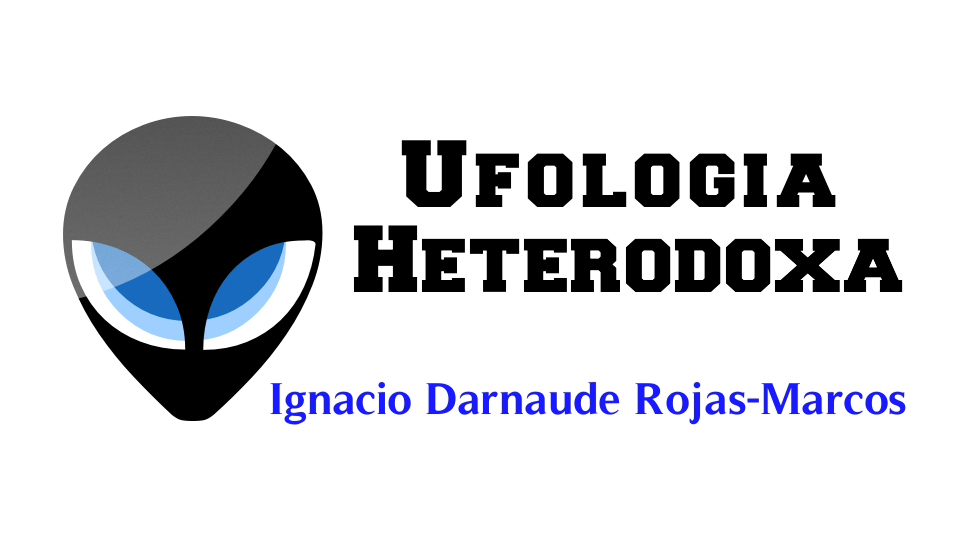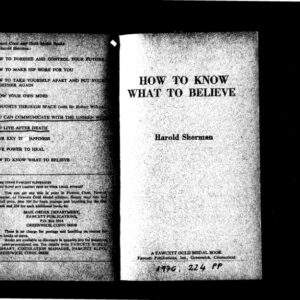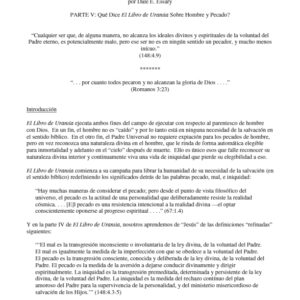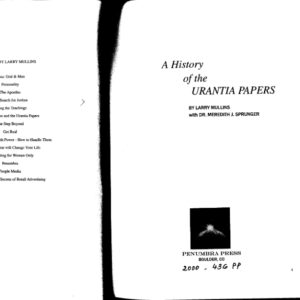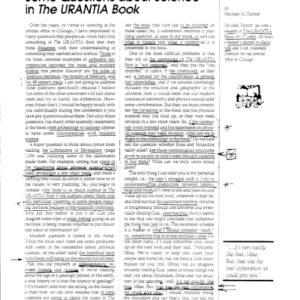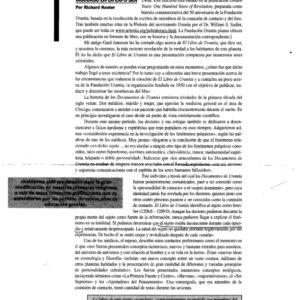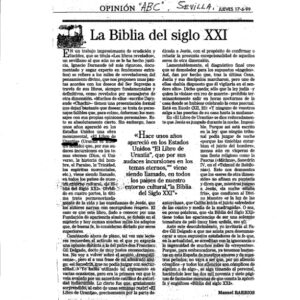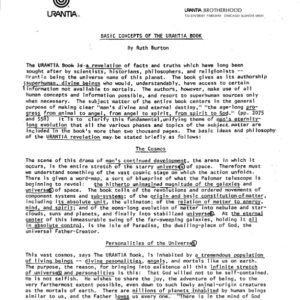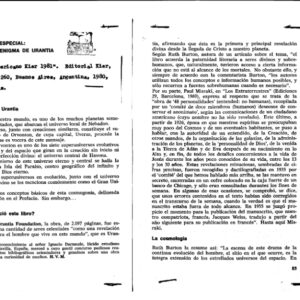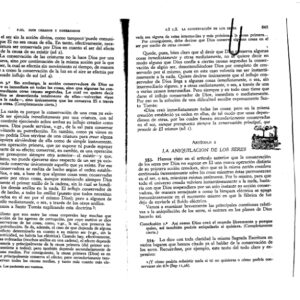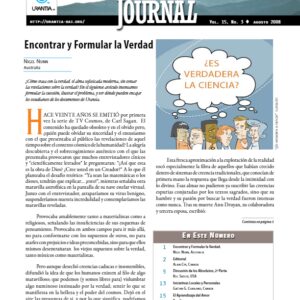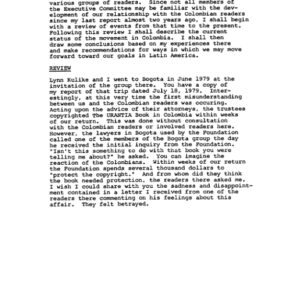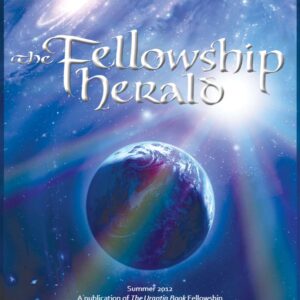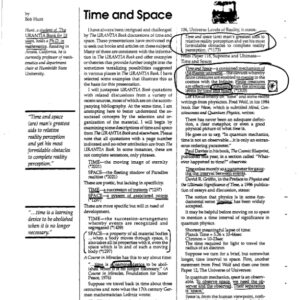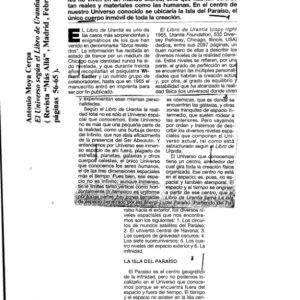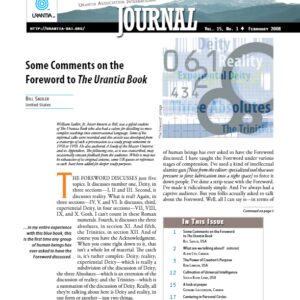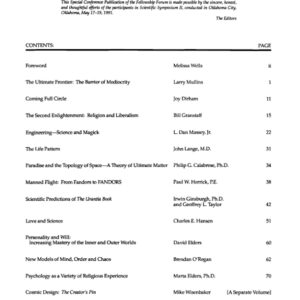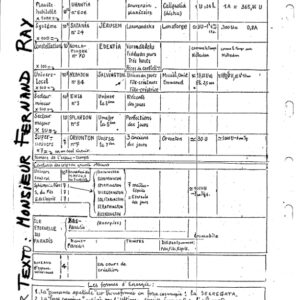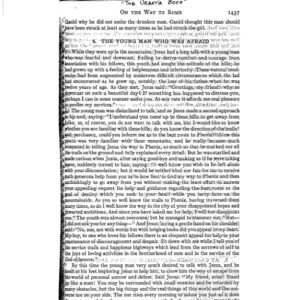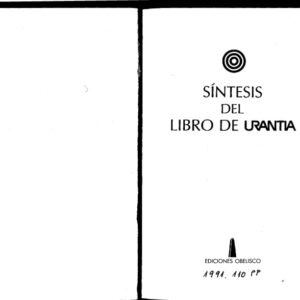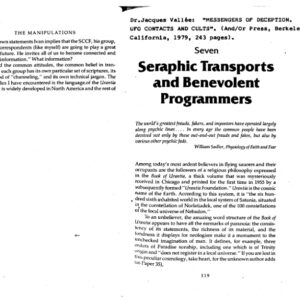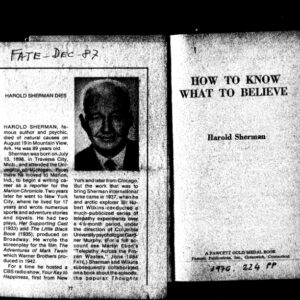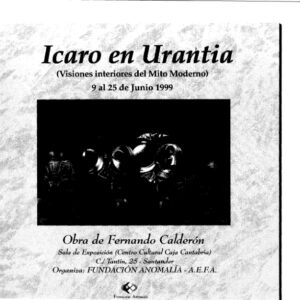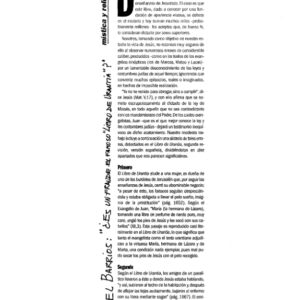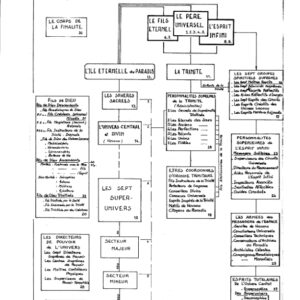Urantia book news 2007
- Descripción
Descripción
Tycho’s Nova: Class C Report
[Updated 11/12/07]
On the one hand, The Urantia Book gives some very specific information about Tycho’s Nova, and it required significant technological advances and the development of complex scientific analysis to corroborate The Urantia Book’s assertion. It took decades after The Urantia Book’s publication in 1955 for astronomers to catch up, and there was not speculation in the scientific community either way about Tycho’s Nova having a double star origin prior to 1955.
On the other hand, this is a single-issue topic. The Urantia Book makes just one statement on this specific subject. Additionally, there can be no direct observation of the assertion that a double star system gave rise to the supernova; once a supernova occurs the opportunity to observe it is gone and Tycho’s Nova occurred hundreds of years ago, long before we had the technology to directly observe whether it originated as a double star. Therefore, forensic analysis is required to make assertions about its origin.
Tycho’s Nova Report
Prepared by Chris Halvorson, PhD and Halbert Katzen, JD with special thanks to Phil Calabrese, PhD [Updated 02/18/08]
Most of the reports at UBtheNEWS involve corroborations of information found in the middle third of The Urantia Book, The History of Urantia [Earth], where it recounts the history of our planet. This report, however, relates to a comment made earlier in the book, which extensively describes aspects of our «local universe,» our local section of the galaxy. Chapter 41, Physical Aspects of the Local Universe, makes the following comments about suns in Section 3, Our Starry Associates:
When suns that are too large are thrown off a nebular mother wheel, they soon break up or form double stars. All suns are originally truly gaseous, though they may later transiently exist in a semiliquid state. When your sun attained this quasi-liquid state of supergas pressure, it was not sufficiently large to split equatorially, this being one type of double star formation.
When less than one tenth the size of your sun, these fiery spheres rapidly contract, condense, and cool. When upwards of thirty times its size-rather thirty times the gross content of actual material-suns readily split into two separate bodies, either becoming the centers of new systems or else remaining in each other’s gravity grasp and revolving about a common center as one type of double star.
The most recent of the major cosmic eruptions in Orvonton [a part of the universe described in The Urantia Book that is much larger than our local universe and in which our local universe is located] was the extraordinary double star explosion, the light of which reached Urantia in A.D. 1572. This conflagration was so intense that the explosion was clearly visible in broad daylight. (Urantia Book 41:3.3-5)1
In order to appreciate how this statement, published in The Urantia Book in 1955, was ahead of science, one needs to acquire both a general understanding of how the science has developed regarding supernovae and a specific understanding of how this history of science relates to Tycho’s Nova, the supernova explosion of 1572 to which The Urantia Book refers. But, before learning about the history of supernovae in general and Tycho’s Nova in particular, we will start with defining what a double star is. The following quotes from Wikipedia provide a basic description of a double star and indicate how «double» and «binary» are used interchangeably in reference to this occurrence:
A double star is when two stars appear close to each other as seen from Earth.
There are two kinds of double star: visual binaries and optical binaries. Visual binaries are considered to be a true binary star system and lie close enough together in space to interact gravitationally such that the stars orbit each other. Optical binaries (aka optical doubles), on the other hand, are two stars that only appear to be close together, and are actually separated by a great distance in space and are not gravitationally bound to each other.2
A binary star is a stellar system consisting of two stars orbiting around their center of mass. For each star, the other is its companion star. . .
It is believed that a quarter to half of all stars are in binary systems, with as many as 10% of these systems containing more than two stars (triples, quadruples, etc.).3
Advances in the quality and types of telescopes used to observe the universe have allowed astronomers to better appreciate the frequency of binary stars. These developments cover the time period before and after The Urantia Book was published. At the time of publication the frequency of binary star systems was not thought to be as high as it is today. This change in our appreciation for the frequency of binary systems has occurred because many binary systems could not be identified until more advanced technologies made it possible to recognize them as such.
Similarly, there have been changes to the classification models of supernovae that span the time period before and after publication. The original classification system of supernovae had to do with brightness and other energy emanations.
Supernovae are classified based on the presence or absence of certain features in their optical spectra taken near maximum light. They are broadly divided into 4 main Types, the naming convention of which only makes sense in historical context.
Supernovae were first categorized in 1941 when Rudolph Minkowski recognized that at least 2 different types existed, those that showed hydrogen (H) in their spectra: Type II, and those that did not: Type I. In the mid-1980s as the rate of supernova discoveries increased and data quality improved, Type I supernovae were further sub-divided based on the presence or absence of silicon (Si) and helium (He) in their spectra. Type Ia supernovae contain an obvious Si absorption at 6150 Angstoms [angstroms], Type Ib have no Si but show He in emission, and Type Ic display neither Si nor He. It was also discovered that while Type Ia supernovae could be found anywhere and in any type of galaxy, Type Ib and Type Ic supernovae occurred primarily in populations of massive stars, similar to Type IIs.
We now know that Type II, Type Ib and Type Ic supernovae result from the core-collapse of massive stars, while Type Ia supernovae are the thermonuclear explosions of white dwarfs. Even so, and to the confusion of many, astronomers continue to use the nomenclature tied to the original Minkowski types to classify supernovae.4

CLASSIFICATIONS OF SUPERNOVAE
The classifications of supernovae into groups that originate from single and double star systems did not occur until after 1955. This fact is referenced by Wikipedia in the following history of our developing appreciation for the nature of supernovae:
The true nature of the supernova remained obscure for some time. Observers slowly came to recognize a class of stars that undergo long-term periodic fluctuations in luminosity. Both John Russell Hind in 1848 and Norman Pogson in 1863 had charted stars that underwent sudden changes in brightness. However these received little attention from the astronomical community. In 1866, however, William Higgins made the first spectroscopic observations of a nova, discovering lines of hydrogen in the unusual spectrum of the recurrent nova T Coronae Borealis. Higgins proposed a cataclysmic explosion as the underlying mechanism, and his efforts drew interest from other astronomers.
In 1885, a nova-like outburst was observed in the direction of the Andromeda galaxy by Ernst Hartwig in Estonia. S Andromedae increased to 6th magnitude, outshining the entire nucleus of the galaxy, then faded in a manner much like a nova. However, in 1917, George W. Ritchey measured the distance to the Andromeda galaxy and discovered it lay much further than had previously been thought. This meant that S Andromedae, which did not just lie along the line of sight to the galaxy but had actually resided in the nucleus, released a much greater amount of energy than was typical for a nova.
Early work on this new category of nova was performed during the 1930s by Walter Baade and Fritz Zwicky at Mount Wilson Observatory. They identified S Andromedae, what they considered a typical supernova, as an explosive event that released radiation approximately equal to the Sun’s total energy output for 107 years. They decided to call this new class of cataclysmic variables super-novae, and postulated that the energy was generated by the gravitational collapse of ordinary stars into neutron stars.
Although supernova[e] are relatively rare events, occurring on average about once a century in the Milky Way, observations of distant galaxies allowed supernovae to be discovered and examined more frequently. The first spectral classification of these distant supernova[e] was performed by Rudolph Minkowski in 1941. He categorized them into two types, based on whether or not lines of the element hydrogen appeared in the supernova spectrum. Zwicky later proposed additional types III, IV and V, although these are no longer used and now appear to be associated with single peculiar supernova types. Further sub-division of the spectra categories resulted in the modern supernova classification scheme.
In the aftermath of the Second World War, Fred Hoyle worked on the problem of how the various observed elements in the universe were produced. In 1946 he proposed that a massive star could generate the necessary thermonuclear reactions, and the nuclear reactions of heavy elements were responsible for the removal of energy necessary for a gravitational collapse to occur. The collapsing star became rotationally unstable, and produced an explosive expulsion of elements that were distributed into interstellar space. The concept that rapid nuclear fusion was the source of energy for a supernova explosion was developed by Hoyle and William Fowler during the 1960s.
The modern standard model for Type Ia supernova[ ] explosions is founded on a proposal by Whelan and Iben in 1973, and is based upon a mass-transfer scenario to a degenerate companion star. In particular, the light curve of SN 1972e in NGC 5253, which was observed for more than a year, was followed long enough to discover that after its broad «hump» in brightness, the supernova faded at a nearly constant rate of about 0.01 magnitudes per day. Translated to another system of units, this is nearly the same as the decay rate of cobalt-56 (56Co), whose half-life is 77 days. The degenerate explosion model predicts the production of about a solar mass of nickel-56 (56Ni) by the exploding star. The 56Ni decays with a half-life of 6.8 days to 56Co, and the decay of the nickel and cobalt provides the energy radiated away by the supernova late in its history. The agreement in both total energy production and the fade rate between the theoretical models and the observations of 1972e led to rapid acceptance of the degenerate-explosion model.5
The statement above about how «The modern standard model for Type Ia supernova[ ] explosions is founded on a proposal by Whelan and Iben in 1973, and is based upon a mass-transfer scenario to a degenerate companion star,» indicates that the assertion made by The Urantia Book in 1955 that Tycho’s Nova had a double star origin was about twenty years ahead of its time.
In the lead up to providing information on some of the more recent research that indicates astronomers may have found Tycho’s companion star, researchers with the Isaac Newton Group of Telescopes in a 2005 article called The Search for the Companion Star of Tycho Brahe’s 1572 Supernova give us another look at the development of the theory that all Type Ia supernovae have a double star origin:
In recent years, type Ia supernovae (SNe Ia) have been used successfully as cosmological probes of the Universe (Riess et al., 1998; Perlmutter et al., 1999). However, the nature of their progenitors has remained somewhat of a mystery. It is widely accepted that they represent the disruption of a degenerate object, but there are also numerous progenitor models (see for instance Ruiz-Lapuente, Canal, Isern, 1997a, for a review), but most of these have serious theoretical/observational problems or do not appear to produce sufficient numbers to explain the observed frequency of SNe Ia in our Galaxy.
Hoyle and Fowler (1960) described how a white dwarf, a common end-point in the evolution of low- and intermediate- mass stars, could become a powerful fusion bomb if its interior temperature rose from about 2 x 108 to 5 x 108 K. They anticipated that this type of explosion could well correspond to the class of objects identified by Minkowski (1941), called supernovae of type I and much later renamed type Ia. These supernovae are characterized by their spectral signatures and are the brightest observable stellar explosions.
But, how can such high temperatures (>108 K) be attained in the usually cold degenerate cores of white dwarfs? A natural way to heat white dwarfs up is by the accretion of material from a stellar companion. If the white dwarf grows in mass by taking material from a donor star, its central density and temperature rise, and it can achieve the critical condition near 1.4 solar masses, the so-called Chandrasekhar mass. The binary path is found to be the easiest physical way to give rise to bare white dwarfs exploding in large enough numbers to account for those supernovae. The single-star models were both physically and statistically unsuccessful. Recently, new momentum has been given to the study of possible evolutionary paths to explosion. Observational efforts with specific goals have been set up to clarify the issue by contrasting the models with empirical evidence.6
Having established that it was not until after 1955 that the scientific community came to accept that all Type Ia supernovae have a double star origin, we now turn our attention to the history of the classification of Tycho’s Nova as Type Ia. In a 1945 article W. Baade put forth the following analysis, classifying Tycho’s Nova as a Type I supernova:
The light-curve of the nova of 1572, derived from Tycho’s observations, shows that the star was a supernova of type I which reached at maximum the apparent magnitude of -4.0.
The fact that no expanding shell can be detected at the place where the supernova flared up indicates that the excitation provided by the stellar remnant is insufficient. This, in turn, suggests that the star is much more advanced toward the final white-dwarf state than are the stellar remnants of the supernovae of A.D. 1054 and 1604.
It has been pointed out in a previous paper (W.Baade, Mt. W. Conlr., No. 600; Ap.J., 88, 285, 1938) that B Cassiopeiae, the bright nova of 1572, was undoubtedly a supernova because of its amplitude, which exceeded 22 mag. The recent recognition of two types of supernovae makes it desirable to decide whether the star was a supernova of type I or type II. The light-curve of the nova, derived in the present paper, clearly indicates a supernova of type I. Because it throws new light on the final state of a supernova, B Cas is of particular interest.
It is impossible at present to press the search for the stellar remnant of B Cas to still fainter limits, since the nova, on account of its high declination, cannot be reached with the 100-inch telescope. However, there is every prospect that it will be found when the 200-inch telescope comes into operation.7
The existence of double stars was established prior to 1955. Determining that Tycho’s Nova should be classified as Type I occurred prior to 1955 based on the observational data provided by Tycho Brahe. However, relocating and identifying Tycho’s Nova as having a binary origin did not occur until after 1955.
The process of first identifying the location of the remnant of Tycho’s Nova and then placing it in the category of supernovae with a double star origin began in 1952 through the use of radio wave detection. Identification through optical recognition did not occur until after 1955. The quote below from Nature magazine, submitted July 14 by R. Hanbury Brown & C. Hazard for the August 1952 edition, indicates that the radio waves from Tycho’s Nova had not yet been detected. The one following it shows that by the end of the year the discovery of its radio waves had been made.
SINCE the discovery of localized sources of extraterrestrial radio-frequency radiation in 1948, surveys have been carried out over the whole sky, and the positions and intensities of about one hundred sources are now known. Although a few of these sources have been identified with extra-galactic nebulae, it is generally considered that the majority must lie within the Galaxy with a distribution, and perhaps a density, similar to that of the common visual stars. However, it has not yet been possible to associate the radio sources with any class of visual objects in the Galaxy, and in only one instance has an identification been made, namely, the identification of a source in Taurus with the Crab nebula. As the Crab nebula is believed to be the remnant of the supernova of 1054, it is to be expected that the remnants of other supernovae are also sources of radio radiation. The other supernovae known to have occurred in the Galaxy are those of 1572 and 1604, but the published surveys show no radio source in either of these positions.8
The . . . remnant is the result of the supernova explosion in 1572 which was studied by Tycho Brahe . . . and has since been called Tycho’s nova, otherwise know as Nova B Cassiopia. The remnant was first discovered in 1952 by Hanbury Brown and Hazard as a strong radio source. Subsequently, Minkowski found the optical remnant associated with the radio source. Tycho’s nova is now known also as a strong source of X-ray emission. Analyzing the old records of this nova, Baade concluded that at maximum it had an apparent visual magnitude of -4, its light curve corresponding to that of a Type I supernova.9
Sol Company on their SolStation.com website provides this overview:
The remnant of the supernova was not found until 1952, with the help of the Jodrell Bank radio telescope (Brown and Hazard, 1953), catalogued as radio source 3C 10. Shortly thereafter, faint optical wisps in the same location were discovered using the 200-inch telescope at Mt. Palomar during the 1960s, when an extremely faint nebulosity was identified on photo plates. The gas shell is now expanding at about 5,600 miles (9,000 km) per second — much more than the Crab Nebula’s expansion speed of about 600 miles (1,000 km) per second — and has grown to about 3.7 arc-minutes — around 24 light-years (ly) wide according to one estimate. However, no central point source has been detected within the Tycho supernova remnant (SNR), which is consistent with other evidence that the SNR was created by a Type-Ia supernova.10
Additional history related to Tycho’s Nova is summarized in Wikipedia:
SN 1572 or Tycho’s Nova was a supernova in the constellation Cassiopeia, one of the eight supernovae visible to the naked eye. It was first observed on November 11, 1572 by the Danish scientist Tycho Brahe, when it was brighter than Venus. In March 1574 its brightness fell below visibility with the naked eye.
Tycho Brahe may not have been the first to notice the supernova; it was probably Wolfgang Schuler, who first saw it on November 6, 1572. The Italian astronomer Francesco Maurolico may also have spotted it before Tycho.
The supernova remnant was discovered in the 1960s by scientists at the Mount Palomar telescope as a very faint nebula. It was later photographed by a telescope on the international ROSAT spacecraft. The supernova was probably of Type Ia, in which a white dwarf star has accreted matter from a companion until it reaches the Chandrasekhar limit and explodes. This type of supernova does not typically create the spectacular nebula more typical of Type II supernovas, such as SN 1054 which created the Crab Nebula. A shell of gas is still expanding from its center at about 9,000 km/s.
In October 2004, a letter in Nature reported the discovery of a G2 star, similar in type to our own Sun. It is thought to be the companion star that contributed mass to the white dwarf that ultimately resulted in the supernova. A subsequent study, published in March 2005, revealed further details about this star: labeled Tycho G, it was likely a main sequence star or subgiant prior to the explosion, but had some of its mass stripped away and its outer layers shock-heated from the effects of the supernova. Tycho G’s current velocity is perhaps the strongest evidence that it was the companion star to the white dwarf, as it is traveling at a rate of 136 km/s, which is more than forty times faster than the mean velocity of other stars in its stellar neighbourhood.11

X-ray image of the SN 1572 remnant


Research reports from 2004 and 2005 indicate astronomers believe they have found the companion. These recent developments, nearly fifty years after The Urantia Book’s assertion that Tycho’s Nova originated as a double star, lend additional support to the previously and widely held belief by astronomers that Tycho’s Nova did in fact have a double star origin.
Researchers with the Isaac Newton Group explain the new findings in this way:
A particularly conclusive test would be the detection of a companion star that has survived the supernova explosion in the supernova remnant. At present the detection of a surviving companion would only be feasible in our Galaxy. The supernova of the millennium, the Lupus supernova (also designated SN 1006 after the year of its appearance) was a supernova of this type. The supernova discovered by Tycho Brahe, SN 1572, was also of this type. Both are the only unambiguous type Ia supernovae observed in our Galaxy during the last thousand years.12
Observable Consequences on the Companion Star
The predictions of how the companion star would look after the impact of the supernova ejecta, if there is any companion, were investigated by Canal, Méndez and Ruiz-Lapuente (2001), depending on the type of star it actually is. Among other features, the surviving companion star should have a peculiar velocity with respect to the average motion of the other stars at the same location in the Galaxy -mainly due to disruption of the binary- detectable through proper-motion and radial velocity measurements, and perhaps also signs of the impact of the supernova ejecta. The latter can be twofold. First, mass should have been stripped from the companion and thermal energy injected into it, possibly leading to the expansion of the stellar envelope that would make the star have a lower surface gravity. Second, depending on the interaction with the ejected material, the surface of the star could be contaminated by the slowest- moving ejecta made of Fe and Ni isotopes. If the companion’s stellar envelope is radiative, such a contamination could be detectable through abundance measurements.
The Search for the Companion Star of SN 1572
Tycho Brahe’s supernova (SN 1572) is one of the only two supernovae observed in our Galaxy that are thought to have been of Type Ia as revealed by the light curve (Ruiz-Lapuente, 2004), radio emission (Baldwin et al., 1957) and X-ray spectra (Hughes et al., 1995).
The field that contained Tycho’s supernova, relatively devoid of background stars, is favorable for searching for any surviving companion. With a Galactic latitude b=+1.4°, Tycho’s supernova lies 59-78 pc above the Galactic plane. The stars in that direction show a consistent pattern of radial velocities with a mean value of -30 km/s at 3 kpc. The star most likely to have been the mass donor of SN 1572 has to show a multiple coincidence: being at the distance of SN 1572, showing an unusual motion in comparison to the stars at the same location, having stellar parameters consistent with being struck by the supernova explosion and lying near the remnant centre.
The distance to SN 1572 inferred from the expansion of the radio shell and by other methods lies around 3 kpc. Such a distance, and the light-curve shape of SN 1572, are consistent with it being a normal Type Ia supernova in luminosity, like those commonly found in cosmological searches (Ruiz-Lapuente, 2004).13
Our search for the binary companion of Tycho’s supernova has excluded giant stars. It has also shown the absence of blue or highly luminous objects as post-explosion companion stars. One of the stars, Tycho G of our sample, show[s] a high peculiar velocity (both radial and tangential velocities), lies within the distance range for the explosion of SN 1572, and its type, G2IV, fits the post-explosion profile of a Type Ia supernova companion whose position in the Hertzsprung-Russell diagram is untypical for a standard subgiant.
If Tycho G is the companion star of SN1572, its overall characteristics imply that the supernova explosion affected the companion mainly through the kinematics. Therefore, a star very similar to our Sun but of a slightly more evolved type would have been the mass donor that triggered the explosion of Type Ia SN1572, connecting the supernova explosion to the family of cataclysmic variables.
The results of this research, led by Pilar Ruiz-Lapuente of the University of Barcelona, was published in the October 28 issue of Nature. The co-authors are Fernando Comeron (ESO), Javier Méndez (University of Barcelona and ING), Ramón Canal (University of Barcelona), Stephen Smartt (IoA, Cambridge), Alex Filippenko (University of California, Berkeley), Robert Kurucz (Harvard-Smithsonian Centre for Astrophysics), Ryan Chornock and Ryan Foley (University of California, Berkeley), Vallery Stanishev (Stockholm University), and Rodrigo Ibata (Observatory of Strasbourg).14
The assertion by The Urantia Book in 1955 regarding the double star origin of SN 1572, Tycho’s Nova, was nearly twenty years ahead of the contemporary appreciation by the scientific community that supernovae of this kind originate as double stars. The research reported in 2004 and 2005 further establishes that Tycho’s Nova has been appropriately identified as a Type Ia supernova.
- Citations to The Urantia Book are provided in the above format. In the present case, 41 refers to the chapter (referred to as a «Paper» in The Urantia Book); 3 refers to the section; and 3-5 refers to the paragraphs.
- http://en.wikipedia.org/wiki/Double_star
- http://en.wikipedia.org/wiki/Binary_star
- http://astronomy.swin.edu.au/cosmos/S/Supernova+Classification
- http://en.wikipedia.org/wiki/History_of_supernova_observation
- http://www.ing.iac.es/PR/newsletter/news9/science7.html
- B Cassiopeiae as a Supernova of Type I (Contributions from the Mount Wilson Observatory, Carnegie Institution of Washington, No. 711.), W. Baade, Mount Wilson Observatory, Received June 13, 1945 http://articles.adsabs.harvard.edu/cgi-bin/nph-iarticle_query?db_key=AST&bibcode=1945ApJ…102..309B&letter=.&classic=YES&defaultprint=YES&whole_paper=YES&page=309&epage=309&send=Send+PDF&filetype=.pdf
- http://www.nature.com/nature/journal/v170/n4322/abs/170364a0.html
- An Introduction to Astrophysics by Baidyanath Basu, p. 262
- http://www.solstation.com/x-objects/tycho-s.htm
- http://en.wikipedia.org/wiki/SN_1572
- http://www.ing.iac.es/PR/newsletter/news9/science7.html
- http://www.ing.iac.es/PR/newsletter/news9/science7.html
- http://www.ing.iac.es/PR/newsletter/news9/science7.html
Tycho’s Nova Raw Data
Urantia Book quotes:
41:3.3 When suns that are too large are thrown off a nebular mother wheel, they soon break up or form double stars. All suns are originally truly gaseous, though they may later transiently exist in a semiliquid state. When your sun attained this quasi-liquid state of supergas pressure, it was not sufficiently large to split equatorially, this being one type of double star formation.
41:3.4 When less than one tenth the size of your sun, these fiery spheres rapidly contract, condense, and cool. When upwards of thirty times its size-rather thirty times the gross content of actual material-suns readily split into two separate bodies, either becoming the centers of new systems or else remaining in each other’s gravity grasp and revolving about a common center as one type of double star.
41:3.5 The most recent of the major cosmic eruptions in Orvonton was the extraordinary double star explosion, the light of which reached Urantia in A.D. 1572. This conflagration was so intense that the explosion was clearly visible in broad daylight.
http://www.nature.com/nature/journal/v431/n7012/abs/nature03006.html Brief summary
http://www.solstation.com/x-objects/tycho-s.htm best summary and link resource
http://www.nrao.edu/imagegallery/php/level2a.php?class=Galactic_Sources&subclass=Supernova%20Remnants
http://adsabs.harvard.edu/cgi-bin/nph-basic_connect?qsearch=tycho&version=1 link to many scientific reports on Tycho
http://www.nature.com/nature/journal/v170/n4322/abs/170364a0.html 1952 article, not yet discovered in August 1952
http://articles.adsabs.harvard.edu/cgi-bin/nph-iarticle_query?db_key=AST&bibcode=1945ApJ…102..309B&letter=.&classic=YES&defaultprint=YES&whole_paper=YES&page=309&epage=309&send=Send+PDF&filetype=.pdf 1945 article
http://www.noao.edu/outreach/aop/observers/casstemp.html rediscovered in 1952, National Optical Astronomy Observatory
http://en.wikipedia.org/wiki/SN_1572
http://en.wikipedia.org/wiki/Double_star
http://www.astro.rug.nl/~onderwys/ACTUEELONDERZOEK/JAAR2001/jakob/aozindex.html explanation of Supernova Type 1a
http://deposit.ddb.de/cgi-bin/dokserv?idn=979066697&dok_var=d1&dok_ext=pdf&filename=979066697.pdf
http://history.nasa.gov/SP-466/ch9.htm
http://www.journals.uchicago.edu/ApJ/journal/issues/ApJ/v497n2/37187/37187.html
http://www.sciencedaily.com/releases/2005/09/050923075505.htm
http://hubblesite.org/newscenter/archive/releases/2004/34/text/ Announcement of companion star discovery in 2004
http://books.google.com/books?id=1w5f5Po4XV8C&pg=PA262&lpg=PA262&dq=tycho+brahe+rediscovered+1952&source=web&ots=8Phwz7Wgs_&sig=OiNiaG2S1HcYovI8IC8Oc2dtSPA#PPR1,M1 historical references
http://adsabs.harvard.edu/abs/1984AZh….61.1125P shows no binary classification in early 80’s
http://astronomy.swin.edu.au/cosmos/S/Supernova+Classification supernova classification system
http://www.ubthenews.com/topics/>http://www.ing.iac.es/PR/newsletter/news9/science7.html</a>%20more%20indepth,%20Isaac%20Newton%20Group%20of%20Telescopes,%20text:<br%20/><br%20/><a%20href=
http://astronomy.swin.edu.au/cosmos/T/Type+Ia+Supernova+Progenitors
http://heasarc.gsfc.nasa.gov/docs/objects/snrs/snrstext.html#intro
http://arxiv.org/pdf/astro-ph/0309009
http://adsabs.harvard.edu/full/1993ApJ…413…67V van den Bergh 1993:
The Astrophysical Journal, 413: 67-69, 1993 August 10
